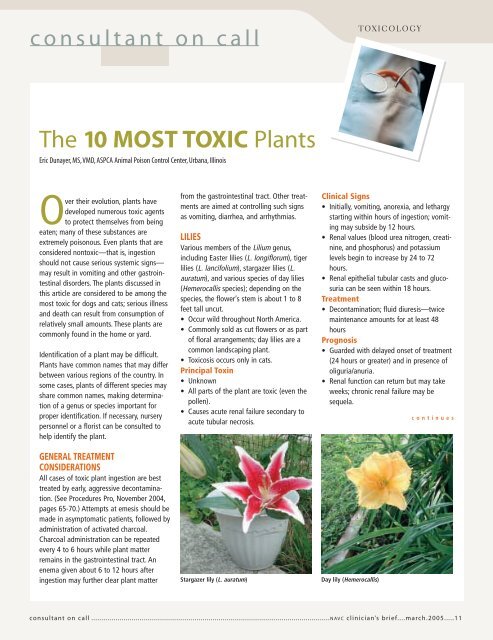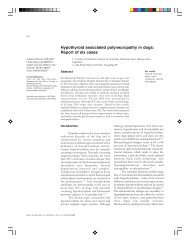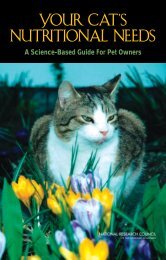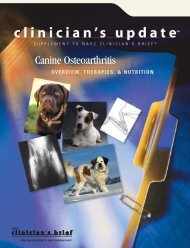The 10 MOST TOXIC Plants
The 10 MOST TOXIC Plants
The 10 MOST TOXIC Plants
Create successful ePaper yourself
Turn your PDF publications into a flip-book with our unique Google optimized e-Paper software.
consultant on call<br />
<strong>TOXIC</strong>OLOGY<br />
<strong>The</strong> <strong>10</strong> <strong>MOST</strong> <strong>TOXIC</strong> <strong>Plants</strong><br />
Eric Dunayer, MS,VMD, ASPCA Animal Poison Control Center, Urbana, Illinois<br />
Over their evolution, plants have<br />
developed numerous toxic agents<br />
to protect themselves from being<br />
eaten; many of these substances are<br />
extremely poisonous. Even plants that are<br />
considered nontoxic—that is, ingestion<br />
should not cause serious systemic signs—<br />
may result in vomiting and other gastrointestinal<br />
disorders. <strong>The</strong> plants discussed in<br />
this article are considered to be among the<br />
most toxic for dogs and cats; serious illness<br />
and death can result from consumption of<br />
relatively small amounts. <strong>The</strong>se plants are<br />
commonly found in the home or yard.<br />
Identification of a plant may be difficult.<br />
<strong>Plants</strong> have common names that may differ<br />
between various regions of the country. In<br />
some cases, plants of different species may<br />
share common names, making determination<br />
of a genus or species important for<br />
proper identification. If necessary, nursery<br />
personnel or a florist can be consulted to<br />
help identify the plant.<br />
GENERAL TREATMENT<br />
CONSIDERATIONS<br />
All cases of toxic plant ingestion are best<br />
treated by early, aggressive decontamination.<br />
(See Procedures Pro, November 2004,<br />
pages 65-70.) Attempts at emesis should be<br />
made in asymptomatic patients, followed by<br />
administration of activated charcoal.<br />
Charcoal administration can be repeated<br />
every 4 to 6 hours while plant matter<br />
remains in the gastrointestinal tract. An<br />
enema given about 6 to 12 hours after<br />
ingestion may further clear plant matter<br />
from the gastrointestinal tract. Other treatments<br />
are aimed at controlling such signs<br />
as vomiting, diarrhea, and arrhythmias.<br />
LILIES<br />
Various members of the Lilium genus,<br />
including Easter lilies (L. longiflorum), tiger<br />
lilies (L. lancifolium), stargazer lilies (L.<br />
auratum), and various species of day lilies<br />
(Hemerocallis species); depending on the<br />
species, the flower’s stem is about 1 to 8<br />
feet tall uncut.<br />
• Occur wild throughout North America.<br />
• Commonly sold as cut flowers or as part<br />
of floral arrangements; day lilies are a<br />
common landscaping plant.<br />
• Toxicosis occurs only in cats.<br />
Principal Toxin<br />
• Unknown<br />
• All parts of the plant are toxic (even the<br />
pollen).<br />
• Causes acute renal failure secondary to<br />
acute tubular necrosis.<br />
Stargazer lily (L. auratum)<br />
Clinical Signs<br />
• Initially, vomiting, anorexia, and lethargy<br />
starting within hours of ingestion; vomiting<br />
may subside by 12 hours.<br />
• Renal values (blood urea nitrogen, creatinine,<br />
and phosphorus) and potassium<br />
levels begin to increase by 24 to 72<br />
hours.<br />
• Renal epithelial tubular casts and glucosuria<br />
can be seen within 18 hours.<br />
Treatment<br />
• Decontamination; fluid diuresis—twice<br />
maintenance amounts for at least 48<br />
hours<br />
Prognosis<br />
• Guarded with delayed onset of treatment<br />
(24 hours or greater) and in presence of<br />
oliguria/anuria.<br />
• Renal function can return but may take<br />
weeks; chronic renal failure may be<br />
sequela.<br />
Day lily (Hemerocallis)<br />
continues<br />
consultant on call ......................................................................................................................NAVC clinician’s brief....march.2005.....11
consultant on call CONTINUED<br />
CASTOR BEAN<br />
Castor bean plants (Ricinus communis)<br />
Ricinus communis<br />
(castor bean plant);<br />
also known as castor<br />
oil plant, mole<br />
bean, wonder tree<br />
• Occurs in the<br />
South, Southwest,<br />
and<br />
California; may Castor beans<br />
be wild or cultivated<br />
for castor oil; plants can stand 3 to<br />
14 feet tall and have large leaves (12<br />
inches or greater).<br />
• <strong>The</strong> beans are used as decorative beads.<br />
Principal Toxin<br />
• Ricin, a glycoprotein<br />
• Blocks protein synthesis, leading to cellular<br />
death.<br />
• Is present in all parts of the plant but<br />
most concentrated in the beans.<br />
• Highly toxic; a single bean can kill a dog.<br />
• <strong>The</strong> outer coating of the bean must be<br />
ruptured (chewed) to release the ricin.<br />
Clinical Signs<br />
• May take up to 24 hours to appear; initial<br />
signs include vomiting and often<br />
bloody diarrhea, abdominal pain, weakness,<br />
and ataxia.<br />
• Hemoconcentration, leukocytosis, and<br />
elevated liver enzymes can be seen on<br />
clinical laboratory testing.<br />
Treatment<br />
• Decontamination; gastrointestinal protectants,<br />
such as sucralfate and histamine<br />
blockers, intravenous fluids, and general<br />
supportive care<br />
Prognosis<br />
• Good with prompt decontamination;<br />
guarded once signs develop<br />
CYCAD PALMS<br />
Sago palm (Cycas revoluta) Courtesy Dr. Camilla Lieske<br />
Many species, but principally sago palm<br />
(Cycas revoluta) and fern palm/false sago<br />
palm (C. circinalis); size varies with species<br />
and can range from 6 to 30 feet tall with<br />
long leaves (up to 9 feet).<br />
• Used as ornamental plants in Florida and<br />
occasionally in California; can be houseplants<br />
in northern climates.<br />
• Sago palms are available as bonsai trees.<br />
Principal Toxin<br />
• Cycasin, a glycoside, yields methylazoxymethanol<br />
after bacteria metabolism<br />
• Cycasin is present in the whole plant, but<br />
concentration is highest in the seeds;<br />
ingestion of as few as 1 to 2 seeds can<br />
cause severe clinical signs and death.<br />
Clinical Signs<br />
• Initially, vomiting, possibly beginning<br />
within a few minutes of ingestion of the<br />
seeds; vomiting may last for hours.<br />
• Hypersalivation and polydipsia can be<br />
seen.<br />
• Over the next few days, anorexia, diarrhea<br />
or constipation, hepatomegaly, and<br />
icterus are seen.<br />
• Neurotoxic effects can be seen but these<br />
may be secondary to hepatic failure.<br />
• Clinical pathology includes thrombocytopenia,<br />
bilirubinemia, elevated hepatic<br />
enzymes, and azotemia.<br />
Pathology<br />
• Liver has a nutmeg appearance.<br />
• Acute centrolobular hepatic necrosis<br />
occurs.<br />
• Fibrosis, bile stasis, and fatty changes<br />
develop over time.<br />
• Petechial hemorrhage and renal tubular<br />
necrosis are also seen.<br />
Treatment<br />
• Symptomatic and supportive care for gastrointestinal<br />
and hepatic signs (antiemetics,<br />
gastrointestinal protectants, such as<br />
sucralfate, adenosyl for liver signs)<br />
Prognosis<br />
• Poor once hepatic necrosis has occurred<br />
RHODODENDRON, AZALEA, LAUREL<br />
Rhododendron (Rhododendron)<br />
Many species of plants from the Ericaceae<br />
(heath) family, including Rhododendron<br />
species (rhododendron, azalea, rosebay),<br />
Kalmia species (laurel), Leucothoe species<br />
(black laurel, fetterbush), Lyonia ligustrina<br />
(maleberry, staggerbush), Pieris japonica<br />
(Japanese pieris), Ledum glandulosum<br />
(Labrador tea)<br />
• Ornamental plant found throughout<br />
North America; size of plant and leaves<br />
varies greatly with species.<br />
12.....march.2005.....NAVC clinician’s brief......................................................................................................................consultant on call
Principal Toxin<br />
• Grayanotoxins (formerly know as<br />
andromedroxtoxin)<br />
• Toxin blocks the sodium channel in cells;<br />
principally affects muscle and nerve cells.<br />
• Whole plant is toxic.<br />
Clinical Signs<br />
• Predominately vomiting, starting within a<br />
few hours of ingestion; diarrhea is rare.<br />
• Aspiration pneumonia is a possible<br />
sequela.<br />
• Cardiac arrhythmias are possible.<br />
• Neurologic signs may include depression,<br />
ataxia, weakness, and seizures.<br />
Treatment<br />
• Symptomatic and supportive care for<br />
vomiting, arrhythmias, and seizures<br />
Prognosis<br />
• Good if seizures or aspiration has not<br />
occurred<br />
YEWS<br />
Yew (Taxus)<br />
Numerous Taxus species<br />
• Occur throughout the United States;<br />
often used as hedges; can grow up to 75<br />
feet high depending on species, but often<br />
are trimmed.<br />
Principal Toxin<br />
• Various taxane derivatives or taxines,<br />
which are negative inotropes and<br />
chronotropes<br />
• All parts of the plant are toxic; deaths<br />
following chewing on branches have<br />
been reported in dogs.<br />
Clinical Signs<br />
• Death may be so rapid that there are no<br />
signs.<br />
• Vomiting and neurologic signs are most<br />
common in dogs, although bradycardia<br />
can also be seen.<br />
Treatment<br />
• Symptomatic care for neurologic and cardiac<br />
signs with atropine and/or lidocaine<br />
Prognosis<br />
• Guarded if signs appear<br />
AUTUMN CROCUSES<br />
Showy autumn crocus (Colchicum speciosum)<br />
Colchicum autumnale (autumn crocus,<br />
meadow saffron); Colchicum speciosum<br />
(showy autumn crocus)<br />
• Occur throughout the United States;<br />
leaves, which grow from the base, can<br />
reach about a foot long; flowers appear<br />
after the leaves have died in the autumn.<br />
Principal Toxin<br />
• Colchicine and similar alkaloids which<br />
prevent cell division<br />
• All parts of the plant are toxic but highest<br />
concentration of the toxin is found in<br />
the flower, the corm, and the seeds.<br />
Clinical Signs<br />
• Signs may take 12 to 24 hours to develop<br />
and initially occur as hypersalivation,<br />
depression, vomiting, milky or bloody<br />
diarrhea, and abdominal pain.<br />
• Progress to weakness, paresis, and collapse.<br />
• Multiple organ failure can occur.<br />
Treatment<br />
• Supportive care including IV fluids with<br />
dextrose and calcium; aspartate should<br />
be given in the IV fluids early in the<br />
course of toxicosis.<br />
Prognosis<br />
• Guarded<br />
FOXGLOVE<br />
Three species<br />
occur in the<br />
United States:<br />
Digitalis purpurea<br />
(common or purple<br />
foxglove); D.<br />
lanata (Grecian<br />
foxglove); and D.<br />
lutea (straw foxglove).<br />
• Occurs wild in<br />
the Pacific<br />
Northwest but is<br />
grown as an<br />
ornamental<br />
throughout<br />
North America;<br />
stems can range<br />
Common foxglove<br />
(Digitalis purpurea)<br />
Courtesy Dr. Anthony Knight.<br />
Reprinted from A Guide to Plant<br />
Poisoning of Animals in North<br />
America. Knight AP, Walter RG.<br />
Jackson, WY: Teton New Media,<br />
2001, p 62, with permission.<br />
from 1 to 6 feet tall with 1- to 2-inch<br />
conical flowers.<br />
Principal Toxin<br />
• Cardenolides, principally digitalis, a cardiac<br />
glycoside<br />
• All parts of the plant are toxic, but highest<br />
concentrations are found in the flowers,<br />
fruit, and immature leaves.<br />
• Dried plant matter retains toxicity.<br />
Clinical Signs<br />
• Initially, gastrointestinal signs are present.<br />
• Cardiac arrhythmias of any type can<br />
occur.<br />
Treatment<br />
• Repeated doses of activated charcoal are<br />
especially efficacious.<br />
• Supportive care for gastrointestinal signs<br />
• Symptomatic control of arrhythmias (e.g.,<br />
atropine for bradycardia, lidocaine for<br />
ventricular tachycardia). Digibind (Savage<br />
Laboratories, Melville, NY), a Fab antibody,<br />
can be used to bind and enhance<br />
elimination of digitalis. However, because<br />
Digibind is expensive, use is generally<br />
restricted to patients with nonresponsive<br />
arrhythmias and severe hyperkalemia.<br />
Prognosis<br />
• Good, unless intractable arrhythmias or<br />
hyperkalemia develops<br />
continues<br />
consultant on call ......................................................................................................................NAVC clinician’s brief....march.2005.....13
consultant on call CONTINUED<br />
LILY OF THE VALLEY<br />
Lily of the Valley (Convallaria majalis) Courtesy Dr.<br />
Camilla Lieske<br />
Convallaria majalis<br />
• Grown as ornamental throughout United<br />
States; plant has broad, erect leaves (4 to<br />
8 inches) with small, bell-shaped flowers.<br />
Principal Toxin<br />
• Cardenolides, potent cardiotoxins<br />
• Toxin is concentrated in the roots, but all<br />
parts of the plant are toxic.<br />
Clinical Signs<br />
• Initial signs are gastrointestinal with<br />
vomiting and hypersalivation; diarrhea is<br />
less common.<br />
• Cardiac signs include bradycardia and<br />
other arrhythmias.<br />
• Seizures may also occur.<br />
• Death may be sudden without any prior<br />
signs.<br />
Treatment<br />
• Same as for foxglove<br />
Prognosis<br />
• Good, unless intractable arrhythmias or<br />
hyperkalemia develops<br />
OLEANDER<br />
Oleander (Nerium oleander) Courtesy Dr. Linnaea Stull<br />
Nerium oleander, also known as laurel rosa,<br />
laurel blanco, laurel colorado, rosa laurel<br />
• Not native to North America; found in the<br />
South and California<br />
• Frequently planted as roadside hedge or<br />
backyard ornamental; can grow from 7 to<br />
20 feet tall.<br />
Principal Toxin<br />
• Cardiac glycosides<br />
• Toxicity often due to ingestion of<br />
dead/dry leaves; green leaves are bitter<br />
and less likely to be eaten; when the leaf<br />
dies, the sugar moiety is released from<br />
the cardiac glycoside, which improves<br />
palatability.<br />
Clinical Signs<br />
• Initially vomiting and diarrhea (the latter<br />
may contain blood)<br />
• Signs may progress to cardiac arrhythmias<br />
of any type (similar to digitalis toxicity).<br />
Treatment<br />
• Symptomatic care for gastrointestinal<br />
signs<br />
• Arrhythmias should be treated symptomatically<br />
(e.g. atropine for bradyarrhythmias,<br />
propranolol/lidocaine for tachyarrhythmias);<br />
consider use of Digibind.<br />
Prognosis<br />
• Good with aggressive therapy<br />
YESTERDAY, TODAY, AND TOMORROW<br />
Yesterday, today, and tomorrow (Brunfelsia grandiflora)<br />
Courtesy Dr. Anthony Knight<br />
Brunfelsia australis. Photograph shows B.<br />
grandiflora; flowers are identical to those of<br />
B. australis but appear in clusters whereas<br />
in B. australis they are spread out over<br />
plant.<br />
• Ornamental found mainly in the South;<br />
grows as a shrub or small tree.<br />
at a glance<br />
• If no significant systemic signs are<br />
expected, treat vomiting and<br />
diarrhea.<br />
• If ingestion is recent and<br />
significant systemic signs are<br />
possible:<br />
- Decontaminate via emesis<br />
- Administer multiple doses of<br />
activated charcoal.<br />
- Give an enema 6 to 12 hours<br />
after ingestion.<br />
• If clinical signs develop:<br />
- Administer IV fluids<br />
- Control vomiting<br />
- Administer gastrointestinal<br />
protectants (if indicated)<br />
- Monitor for and control<br />
arrhythmias as needed<br />
- Consider Digibind in cardiac<br />
glycoside toxicity if nonresponsive<br />
arrhythmias or hyperkalemia<br />
occurs<br />
- Monitor renal and hepatic<br />
values; electrolytes<br />
Principal Toxin<br />
• Brunfelsamidine, a neurotoxin that causes<br />
seizures<br />
• All parts of the plant are toxic.<br />
Clinical Signs<br />
• Coughing, gagging, and nystagmus can<br />
be seen within minutes to hours; tremors<br />
and seizures, usually characterized by<br />
extensor rigidity (may resemble those of<br />
strychnine toxicity)<br />
Treatment<br />
• Supportive care with IV fluids<br />
• Control seizures with diazepam, barbiturates.<br />
Prognosis<br />
• Guarded; signs can last for days and<br />
complete recovery may take weeks. ■<br />
See Aids & Resources, back page, for<br />
references, contacts, and appendices.<br />
14.....march.2005.....NAVC clinician’s brief......................................................................................................................consultant on call








